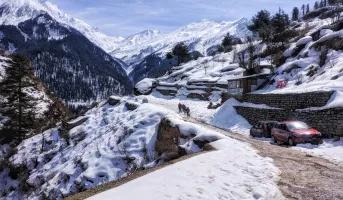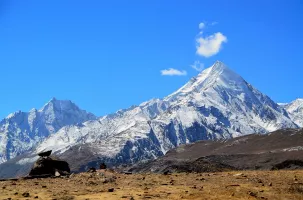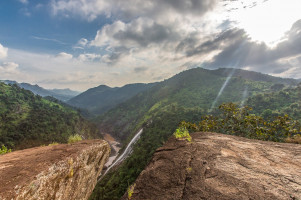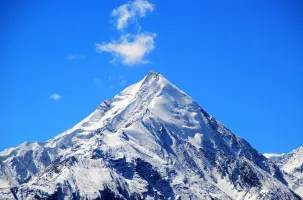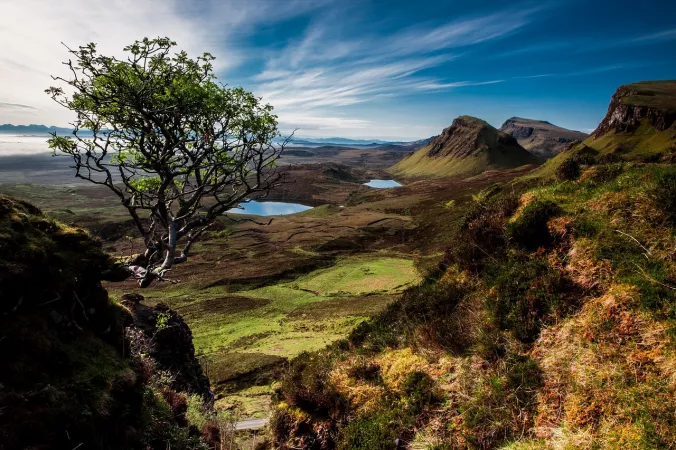
Parvati Valley
Duration
3 to 7 Days
3 to 7 Days
Best time to visit
Apr-Jun, Sep-Oct
Apr-Jun, Sep-Oct
Theme
Hill Station, Adventure, Religious
Hill Station, Adventure, Religious
Parvati Valley Travel Guide
Parvati Valley, located in the northern Indian state of Himachal Pradesh, is a picturesque destination known for its stunning natural beauty and spiritual significance. Nestled in the Himalayas, this valley is famous for its hippie culture, vibrant festivals, and serene landscapes. The valley is named after the Parvati River, which flows through it, adding to its charm.Top Attractions in Parvati Valley
- Kheerganga Trek
- Malana Village
- Manikaran Sahib Gurudwara
- Tosh Village
- Rasol Village
Parvati Valley is Famous for
Its vibrant hippie culture and stunning natural beauty make Parvati Valley famous among travelers looking for a unique and spiritual experience.Top Attractions in Parvati Valley
- Kheerganga Trek - A popular trekking destination with natural hot springs
- Malana Village - Known for its unique culture and beautiful views
- Manikaran Sahib Gurudwara - A sacred place for Sikhs with hot springs
- Tosh Village - A peaceful village offering panoramic views of the valley
- Rasol Village - A hidden gem known for its tranquility and scenic beauty
What's Great about Travelling to Parvati Valley?
- Peaceful and serene environment
- Rich cultural experiences
- Adventure activities like trekking and camping
What's Not So Great about Travelling Parvati Valley?
- Limited accessibility and remote location
- Basic amenities in some areas
- High altitude may cause altitude sickness
Travel Tips for Parvati Valley
- Carry sufficient cash as ATMs may not be easily accessible
- Respect the local culture and customs
- Dress modestly, especially while visiting religious sites
Important Parvati Valley trip information
- Ideal Duration: A week to explore the valley thoroughly
- Best Time to Visit: April to June and September to November for pleasant weather
- Nearby Airports and Railway Stations: The nearest airport is Kullu-Manali Airport, and the closest railway station is Joginder Nagar Railway Station
Per Person
9,499
*EXCLUDING APPLICABLE TAXES 4.9 Ratings
( 185 Reviews )
( 185 Reviews )
Per Person
15,500
*EXCLUDING APPLICABLE TAXES 5.0 Ratings
( 4 Reviews )
( 4 Reviews )
Per Person
28,000
*EXCLUDING APPLICABLE TAXES 3.7 Ratings
( 5 Reviews )
( 5 Reviews )
Per Person
10,000
*EXCLUDING APPLICABLE TAXES 5.0 Ratings
( 157 Reviews )
( 157 Reviews )
Per Person
18,500
*EXCLUDING APPLICABLE TAXES 5.0 Ratings
( 4 Reviews )
( 4 Reviews )
Per Person
14,500
*EXCLUDING APPLICABLE TAXES 5.0 Ratings
( 4 Reviews )
( 4 Reviews )
FAQ's on Parvati Valley
Q1: What is the best time to visit Parvati Valley?
The best time to visit Parvati Valley is during the summer months from April to June and the autumn months from September to November. These periods offer pleasant weather for outdoor activities like trekking and exploring the scenic beauty of the valley. Avoid the monsoon season from July to August due to heavy rainfall which can lead to landslides and road closures. Winter months from December to February are ideal for snow lovers and experiencing a tranquil side of the valley.
Q2: Do I need a visa to travel to Parvati Valley?
Most international visitors to Parvati Valley will need a valid Indian visa. Check the specific visa requirements based on your nationality before planning your trip. Citizens of some countries may be eligible for visa on arrival or e-visa facilities. Make sure to have your passport and visa documents in order before traveling to Parvati Valley.
Q3: What are the must-visit attractions in Parvati Valley?
Parvati Valley is known for its stunning landscapes and spiritual vibes. Must-visit attractions include the enchanting village of Kasol, the hot springs of Manikaran, the charming town of Tosh, and the iconic Kheerganga trek. Don't miss the Malana village known for its unique culture and heritage. Adventure enthusiasts can explore the challenging trails of Grahan and Rasol. The Parvati River offers picturesque views and opportunities for camping and relaxation amidst nature.
Q4: Is Parvati Valley a safe place to travel?
Parvati Valley is generally safe for travelers. However, it is advisable to be cautious of your surroundings and belongings, especially in crowded tourist areas. Avoid wandering alone at night and always follow basic safety precautions. While the locals are friendly and welcoming, it's recommended to respect the local customs and traditions to ensure a smooth and safe travel experience.
Q5: What is the local currency in Parvati Valley and can I use credit cards?
The local currency in Parvati Valley is the Indian Rupee (INR). ATMs are available in major towns like Kasol and Manikaran for cash withdrawals. Credit cards may not be widely accepted in smaller establishments, so it's advisable to carry sufficient cash for transactions. Currency exchange services may be limited, so it's recommended to exchange money at banks or authorized exchange centers.
Q6: What is the local cuisine like in Parvati Valley?
The culinary scene in Parvati Valley offers a delightful mix of Indian, Tibetan, and Israeli influences. Enjoy local delicacies like Thukpa (noodle soup), Momos (dumplings), and Israeli staples such as Shakshuka and Falafel. Indulge in the famous Israeli breakfast with freshly baked bread and hummus. Don't miss trying the traditional Himachali cuisine like Sidu and Dham. Vegetarian and vegan options are widely available in cafes and restaurants catering to diverse dietary preferences.
Q7: What transportation options are available in Parvati Valley?
Parvati Valley is well-connected by road, and buses are a common mode of transportation to reach destinations within the valley. Local taxis and auto-rickshaws are available for shorter distances. Trekking is a popular way to explore the valley's remote areas and scenic trails. Car and bike rentals are also available in towns like Kasol for independent travel. Shared jeeps and private cabs can be hired for longer journeys to nearby attractions like Manali or Bhuntar.
Q8: Are there any cultural norms or etiquette I should be aware of when visiting Parvati Valley?
When visiting Parvati Valley, it's important to respect the local customs and traditions. Dress modestly, especially when visiting religious sites or interacting with the locals. Seek permission before taking photographs of people or their homes. Avoid littering and maintain cleanliness in public places. While interacting with the locals, greet them with a Namaste and show courtesy in your conversations. Respect the environment and nature by practicing responsible tourism. Embrace the laid-back lifestyle of the valley and immerse yourself in the serene surroundings with a mindful and respectful attitude.
Q9: I am a travel agent. How can I buy travel leads of Parvati Valley?
Register yourself as a travel agent at agents.tripclap.com and then you can buy travel leads to Parvati Valley once your account is approved. For more details contact our support team at +91-8069186564 or support@tripclap.com
